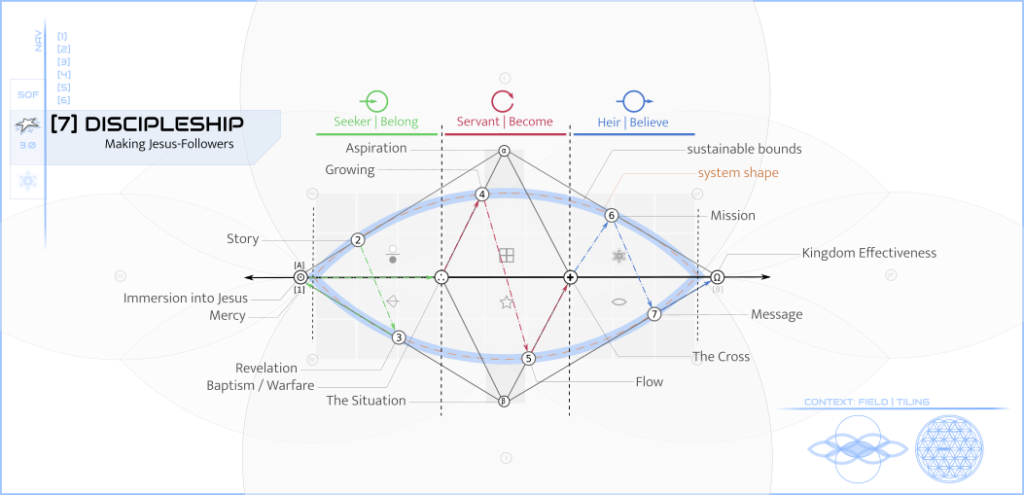
[7] Discipleship
Discipleship illustrates the evolution of a person’s relationship to Jesus and the process of joining him on mission using the [7] The Matrix, the seventh systems shape of the Semantic Ontology Framework (SOF). This Frame represents the growth and development and manifestation of The Kingdom of God in a flow from the personal layer of The Three Levels of self-agency — the internal, psychological world — into the relational and systemic layers which are our connection and life with others and our role in the human and natural systems in which we all live. Discipleship is necessarily relational since both humans are social creatures and God is a community, so it is always happens in the context of Disciple-Making — the shared, collaborative process of helping each other grow in our journey with and towards God. The scaled-up purpose of the process of discipleship is to produce the Kingdom of God as an organic, comprehensive, generative, self-sustaining movement in the shape of [7] The Way of Jesus.
Evolution
Discipleship as a system evolves through three zones, dual-named for the core identity-mode of the disciple and the core experience they encounter in the process (written “Identity | Experience“, such as “Seeker | Belong”). The identity-mode follows the [3] Seeker-Servant-Heir (SSH) framework, while the experience follows [3] Belong-Become-Believe (3Bs). Additionally, at the level of the systems prime — Immersion into Jesus — the role Jesus takes in the disciples life progresses through [3] Lordship-Likeness-Life-on-Life (3Ls).
Belong
Do I feel I have a place with Jesus and his people and do they belong in my story?
Become
How do I become the person who I want to be in Christ and what is he causing my situation to become?
Believe
Where is Jesus leading me to manifest his Kingdom, exercising and demonstrating increasing faith?
Elements
Immersion into Jesus (⊙)
At the heart of discipleship is Immersion into Jesus — it is the Prime: the Source, origin point, and center-of-gravity of the process. It is the ultimate purpose, sustainable principle, and goal of the process. Immersion means a complete and comprehensive experience that effects life universally along the lines of Holarchy: unifying, but also touching on all systemic scales. This is because Jesus is the One in whom all things in Heaven and on Earth converge (Ephesians 1:1-10) — the living incarnation of the Oneness and All-ness of God. Jesus is the Son of God, therefore discipleship is immersion into our own identity and the reality of being God’s child. The name “Jesus” — Yeshua in the original Hebrew — means “God saves”, meaning discipleship is immersion into the participatory experience of God transforming the human situation and our dysfunctional systems — The War Between Kingdoms resolved in the Victory of Jesus through the power of self-sacrifice (investment) and inoculation.
The experience of the Immersion into Jesus evolves through four transitions through the process:
- Immersion into the experience of Jesus (⊙) which is synonymous with the Mercy landmark
- Immersion into the identity of Jesus (∴) which is synonymous with the Baptism / Warfare landmark
- Immersion into the power-reality of Jesus (✛) representing the transition into self-sacrificial mission through the power of death and resurrection which is synonymous with The Cross landmark.
- Immersion into the movement of Jesus (Ω, [8]) as the disciple makes legacy-level contributions to the Kingdom-experience of others. This is synonymous with the Kingdom Effectiveness landmark.
Aspiration (α)
Aspiration is the Alpha or push-force of discipleship. The disciple has a sense of who they want to be — an aspiration — that pushes along the process of growth. As the process matures, the disciples aspiration will become more comprehensive, meaning it will encompass more of the personal, relational, and systemic layer of life.
Situation (β)
The situation of the disciple is the Beta or pull-force of discipleship. The disciple feels the demands of their situation; how it constrains or empowers them and creates a context for their journey. This deepens the process of growth. Again, as the process matures, the disciples awareness of the situation and experience of salvation will grow to encompass the personal, relational, and systemic layers.
Map and Landmark Elements
Discipleship is an iterative1, recursive2, cyclical process that is not strictly linear. This means people may move forward or back in the process, may jump to positions unexpectedly, or navigate positions “out of order”. As such, it’s more useful to think of the framework as a map, not a pipeline. A map does not tell you where to go, just where you are in reference to other places. Using the “map” metaphor, the positions within the process framework and referred to as “landmarks”. A framework — called ELEVATION — further developing the idea of the discipleship / disciple-making process as a metaphorical map is currently under development. The following framework landmarks and language is shared with the Disciple-Making framework due to the relational nature of discipleship.
Seeker | Belong (Source)
LM1: Mercy
The DM makes space within their life, heart, and world for seekers and truly meets and sees them in light of the Oneness and All-ness of God.
LM2: Story
The seeker and DM connect in their lived stories, recognizing and holding in balance the tension between aspiration and situation.
LM3: Revelation
The DM supports the seeker as they encounter the reality of Jesus and his Kingdom in scripture, relationships, and the world around them.
Servant | Become (Cycle)
T1: Baptism & Warfare
The seeker commits to discipleship, with support of the DM, by identifying with the Oneness and All-ness of God and entering into Jesus’ life, Kingdom, and mission.
LM4: Growing
The disciple and DM train to support inward and outward growth using Jesus’ organic strategies for health, sustainability, and fruitfulness in all relationships and systems.
LM5: Flow
The disciple develops with DM their gifting, calling, and style and works to establish and refine Kingdom flows and practices that grow the manifestation of Jesus in community and advance the mission.
Heir | Believe (Drive)
T2: The Cross
Jesus extends his Kingdom deeper and wider in the disciple’s life by the power of death and resurrection requiring a transition from self-growth to other-growth. The DM transitions to “walking alongside” instead of ahead.
LM6: Mission
The disciple and DM discern and map out and execute the disciple’s position in mission, the systems where they will manifest Jesus’ Kingdom, and the discipleship pathways they will establish.
LM7: Message
The disciple and DM create Kingdom experiences that will invite others to begin or deepen their own discipleship journey with Jesus and broadcast these experiences for the common good.
Kingdom Effectiveness (Ω, [8])
Kingdom Effectiveness is the Omega of discipleship: the point at which the system gives birth to spontaneous iterations and recursions. Practically speaking, the disciple has been creating the faith-based reality of the Kingdom of God to impact the lives of others in the Heir | Believe zone of the process. The aggregate effects of this missional lifestyle, lived Life-on-Life with Jesus, leads to legacy-level impacts that spread organically through movement dynamics and create Kingdom realities that can be experienced by others, even far removed from the original disciple. An example of this would be a particularly effective strategy or articulation that spreads many generations of disciples from its original author (with or without attribution).
The idea of legacy and Kingdom Effectiveness is what Paul is refering to in 1 Corinthians 3:9-15:
For we are co-workers in God’s service; you are God’s field, God’s building. By the grace God has given me, I laid a foundation as a wise builder, and someone else is building on it. But each one should build with care. For no one can lay any foundation other than the one already laid, which is Jesus Christ. If anyone builds on this foundation using gold, silver, costly stones, wood, hay or straw, their work will be shown for what it is, because the Day will bring it to light. It will be revealed with fire, and the fire will test the quality of each person’s work. If what has been built survives, the builder will receive a reward. If it is burned up, the builder will suffer loss but yet will be saved—even though only as one escaping through the flames.
1 Corinthians 3:9-15 NIV
The results revealed by Kingdom Effectiveness, or lack of results if the disciple fails to complete the process to this point, reveal the character and effectiveness of the ideas and actions of the process. A tree is known by its fruit, and if a life isn’t producing some movement-level dynamics, there is a flaw in discipleship. Two important things should be noted, however. First, the movement-level dynamics should not be judged by human measures, especially not institutional criteria. For example, a disciple could produce movement-level dynamics around an intangible virtue like compassion, generosity, or faithful service that can be felt in the texture of a movement, but can not be quantified in terms of human transactions or institutional data. Second, Paul makes it clear that reaching the level of movement-level impact is not tied to salvation. Therefore, reaching this level does not make one a true Christian while those who do not are somehow false. The point is not to form an exclusionary criteria, but to apply oneself carefully in the way we build with Jesus so as to suffer as little loss from the flames of judgement as possible.
Meta
Media

Related Entries
References & Notes
- Iterative means the process/system geometry repeats at same scale. For example, each generation of a species represent an iteration of creatures of approximately the same shape and size.
Recursive means the process/system geometry repeats at different scales. For example, the shape of branches in a tree (large scale) recursively repeat on each leaf (smaller scale) — both based on the fractal “branching L-system” geometry.

